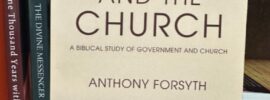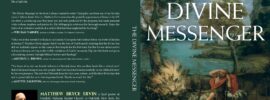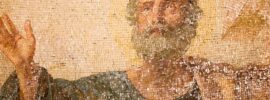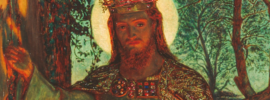
If you’re like me, then you enjoy learning new things. I especially enjoy discovering something I didn’t know existed before, and all the more so if it has to do with something I’ve studied in depth. This recently happened to me. While working on a new project, I happened to come across a passage in the Talmud I had previously overlooked. It concerns the identity of the rider on the red horse in Zechariah 1:8. As a reminder, here is that verse:
I saw at night, and behold, a man was riding on a red horse, and he was standing among the myrtle trees which were in the ravine, with red, sorrel and white horses behind him (Zech 1:8 NASB1995).
And here is the passage from the Talmud. I hope it excites you like it did me:
Rabbi Yoḥanan says: What is the meaning of that which is written: “I saw the night, and behold, a man riding upon a red horse, and he stood among the myrtle bushes that were in the depths” (Zechariah 1:8)? What is the meaning of the phrase “I saw the night”? The Holy One, Blessed be He, sought to transform the entire world into night and destroy it, as there were no righteous people. “And behold, a man riding”; the word “man” is referring to no one but the Holy One, Blessed be He, as it is stated: “The Lord is a man of war, The Lord is His name” (Exodus 15:3).[1]
The rider on the red horse in Zechariah 1:8 is called a “man” because he looked like one. The rider is revealed to be none other than the Angel of the Lord or the Yahweh-Messenger (מַלְאַךְ יְהוָה, Malak YHWH), three verses later, in verse 11. And here, Rabbi Yohanan identified the “man” as the “Holy One,” and as the “LORD” from Exodus 15:3, who is Yahweh.[2] This means that Yohanan believed that the Angel of the Lord, at least in Zechariah 1, was somehow Yahweh Himself. This is certainly something that Christians and Messianic Jews can appreciate. After all, it is a common belief among followers of Jesus that the Angel of the Lord, in many places in the Old Testament, is the preincarnate Son of God. A brief perusal of some classic commentaries makes this plain. For example, the Jamieson-Fausset-Brown Bible Commentary explained that the rider was “Jehovah, the second person of the Trinity, manifested in man’s form, an earnest [foreshadow] of the incarnation . . .”[3] We cannot get into all of the reasons for why this is true here. (I cover the subject in detail in my book, The Divine Messenger: Appearances of the Son of God in the Old Testament.) Suffice it to say that the Angel of the Lord is often presented as both a messenger of Yahweh and as Yahweh Himself. He is also seen, while God the Father has never been seen (John 1:18; 6:46). Now, this isn’t to suggest that the Talmud supports the doctrine of the Trinity or that the eternal Son of God appeared in the Hebrew Bible. This passage from the Talmud does prove, however, that it wasn’t just Christians who believed that the Angel of the Lord was Yahweh in the second and third centuries AD.
Rabbi Yohanan (or Johanan) bar Nappaha (180–279 AD) was one of the most important rabbis in the early days of the Talmud. His teachings and opinions appear thousands of times in both the Babylonian Talmud and in the Jerusalem Talmud. Yohanan’s teachings were meant to be representative of the views of many other rabbis and scholars in his day. The point is that Yohanan’s view, that the Angel of the Lord was Yahweh, wasn’t just unique to him. And even a millennium later, another famous rabbi agreed with him. Rabbi David Kimchi (alternatively Kimhi) is also known by the acronym of his title and name, the RaDaK. A medieval rabbi, Kimchi (1160–1235) remains a respected biblical commentator and grammarian. Kimchi favorably quoted from our Talmud passage in his commentary on Zechariah. Rev. Alexander McCaul, the Chrisitan translator of Kimchi’s commentary, was struck by this. He put the following in a footnote: “This is a remarkable testimony to the belief of the ancient Jews, that He, who appeared in the form of a man, as the angel of the Lord, was the God of Israel.”[4]
My response to the passage mirrors McCaul’s. That’s because it is proof that ancient Jews interpreted the Angel of the Lord in a way that harmonizes with Christian interpretations. That fact isn’t known by many today, since another view from the Talmudic period became the dominate one. Over time, the Angel of the Lord in rabbinic tradition was developed into an exalted, but still created angelic being. He is especially identified as the highest of all angels in rabbinic literature, Metatron (e.g., 3 Enoch 12:5; b. Sanhedrin 38b).[5] This was at least done in part to distance rabbinical Jewish teaching from anything that supported Trinitarianism.
Our Talmud passage above ends with the following:
“Upon a red horse” alludes to the fact that the Holy One, Blessed be He, sought to transform the whole world into blood.[6]
This further portrays the man on the horse as Yahweh prepared to fight against Israel’s enemies. Rabbi Yohanan’s reason for the horse’s color is also shared by many Christian interpreters. The red color of the Angel of the Lord’s horse has historically been understood to symbolize war and bloodshed,[7] as is the case with the red horse taking peace from the earth in Revelation 6:4. Zechariah’s vision concerns actions the Lord would take to ensure that Jerusalem became a prominent city in the world again (Zech 1:16–17). As part of this, it could be that the vision anticipates the day when the Lord Jesus will personally destroy Israel’s enemies. When Jesus returns, he will be riding another horse—a white one—and his robes will be drenched in blood (Rev 19:13). That blood will not be his own; it will be the blood of Israel’s slain enemies (Isa 63:1–6; cf. Zech 14:3; Rev 16:16; 19:15–21).
There are two appearances of the Angel of the Lord in Zechariah’s eight night visions, in the first vision and in the fourth. His appearance in the fourth vision (Zech 3) is among the most impactful for the Christian reader. It is a powerful picture of the imputed righteousness of the Messiah being placed on the sinner. An understanding of who the Angel of the Lord is in Zechariah 1 all the better helps us appreciate who He is as the Redeemer in Zechariah 3.
It is of special interest that during a period when rabbinic traditions were still being developed, a Jewish sage sat down, opened the text, read about the Angel of the Lord, and couldn’t help but come to the conclusion that He was the God of Israel!
[1] b. Sanhedrin 93a, in The William Davidson Talmud. Translated by Rabbi Adin E. Steinsaltz. Sefaria, 2024. https://www.sefaria.org/texts/Talmud
[2] Yahweh is a form of the Tetragrammaton, the four letters of God’s holy name, which are transliterated from the Hebrew as YHWH or YHVH. Because there are no vowels in the name, and because it has long been regarded by the Jews as too sacred to be spoken, the correct pronunciation is uncertain. Most modern scholars prefer Yahweh, while others favor Yehovah (or the Latinized Jehovah). English Bibles typically render the four letters as “LORD” (in all capital letters).
[3] Robert Jamieson, A.R. Fausset, and David Brown, A Commentary: Critical, Practical and Explanatory, on the Old and New Testaments (Toledo, OH: Jerome B Names & Co., 1884), 2: Zech 1:18.
[4] Footnote #2, in David Kimchi. Rabbi David Kimchi’s Commentary Upon the Prophecies of Zechariah. Translated by Alexander McCaul. (London: James Duncan, 1837) 3.
[5] The meaning of the name Metatron is unclear, though some argue it means “behind the throne,” while others say it means “arranger,” “divider,” or “representative.” Some see importance in the name being numerically equivalent to God’s name Shaddai (typically translated as “Almighty”) in Hebrew Gematria (the alphanumeric code by which letters correspond to numbers).
[6] b. Sanhedrin 93a, in The William Davidson Talmud. Translated by Rabbi Adin E. Steinsaltz. Sefaria, 2024. https://www.sefaria.org/texts/Talmud
[7] I personally think that the colors of all four horses in the vision correspond to the colors of the flowers of a myrtle tree. I admit, this is a minority view.










Recent Comments